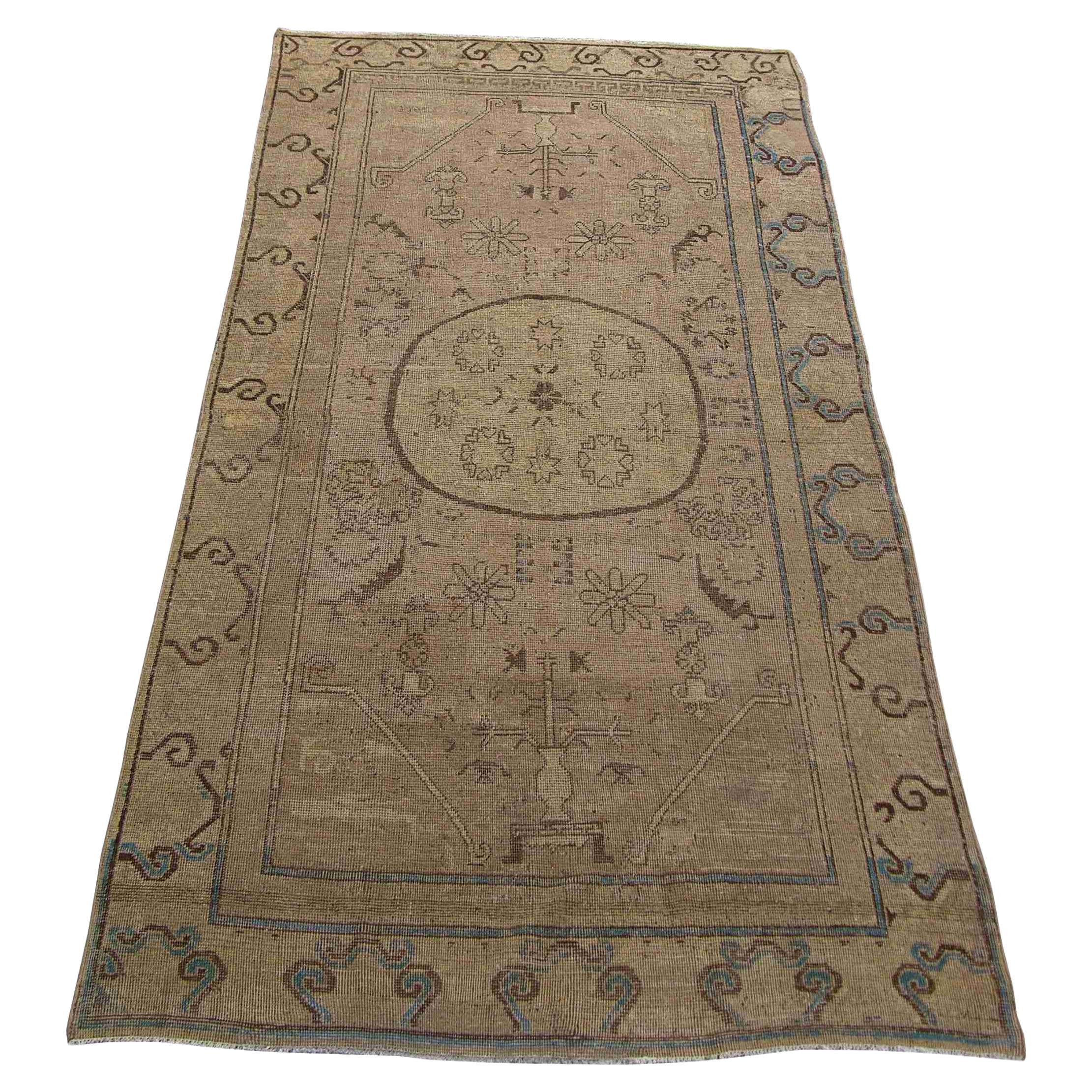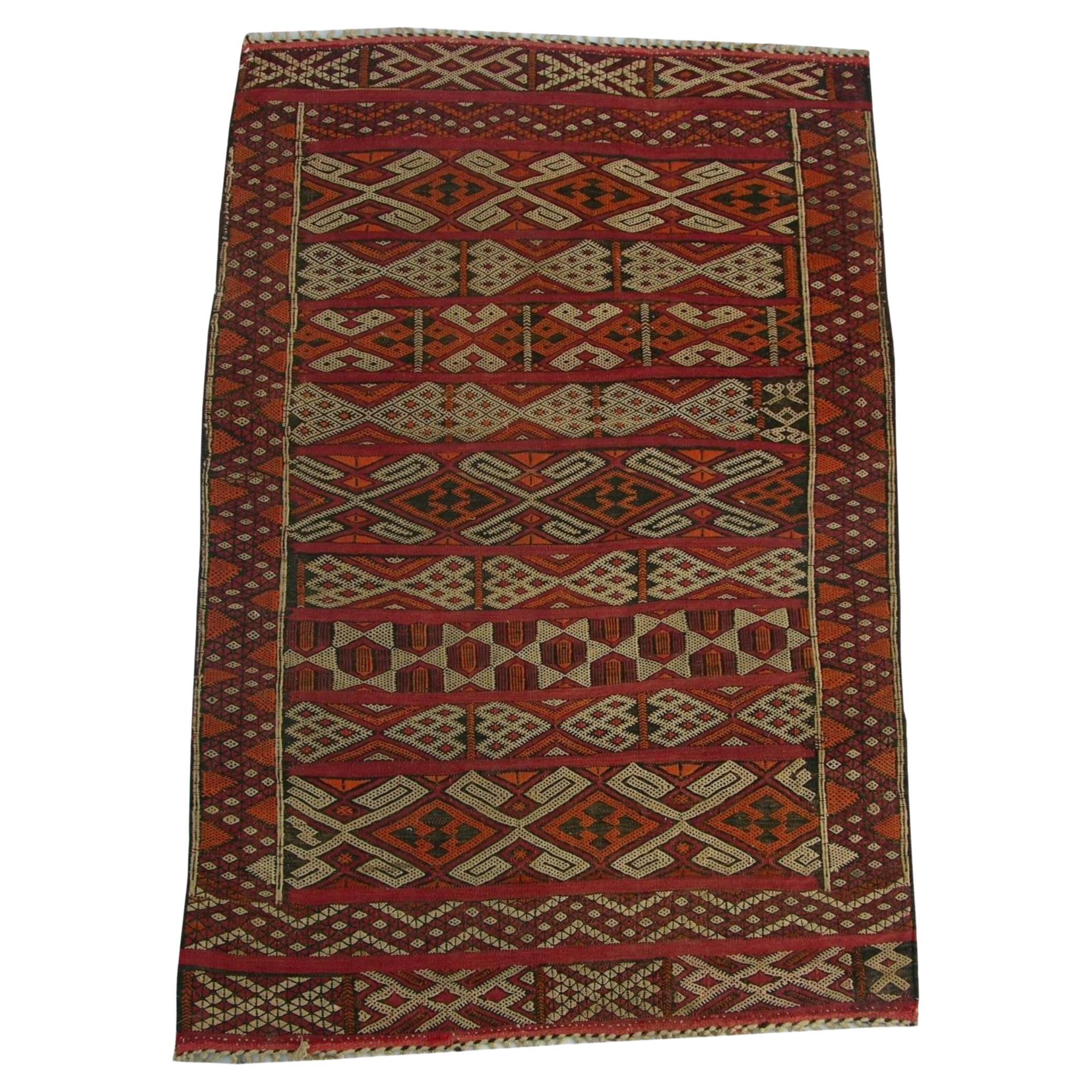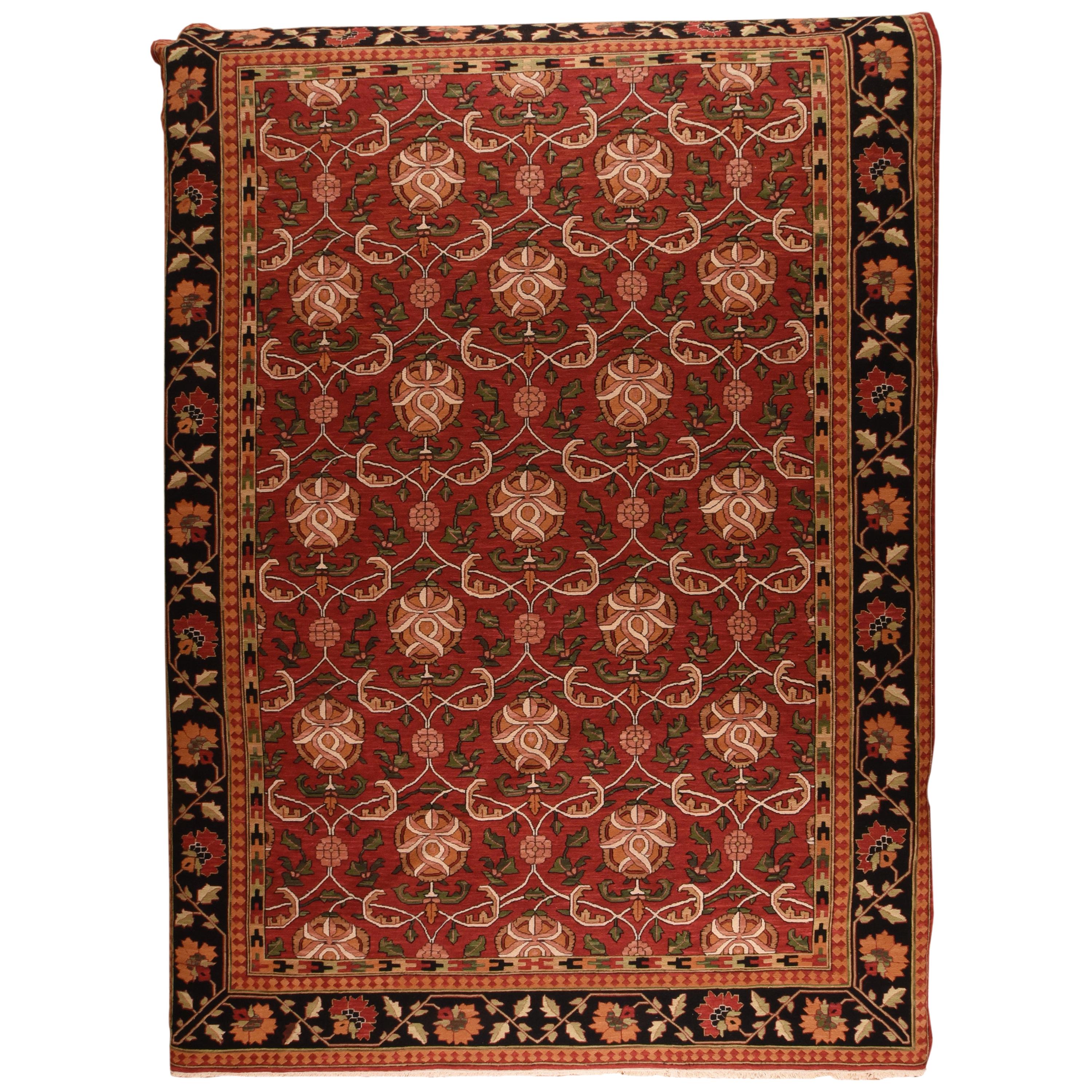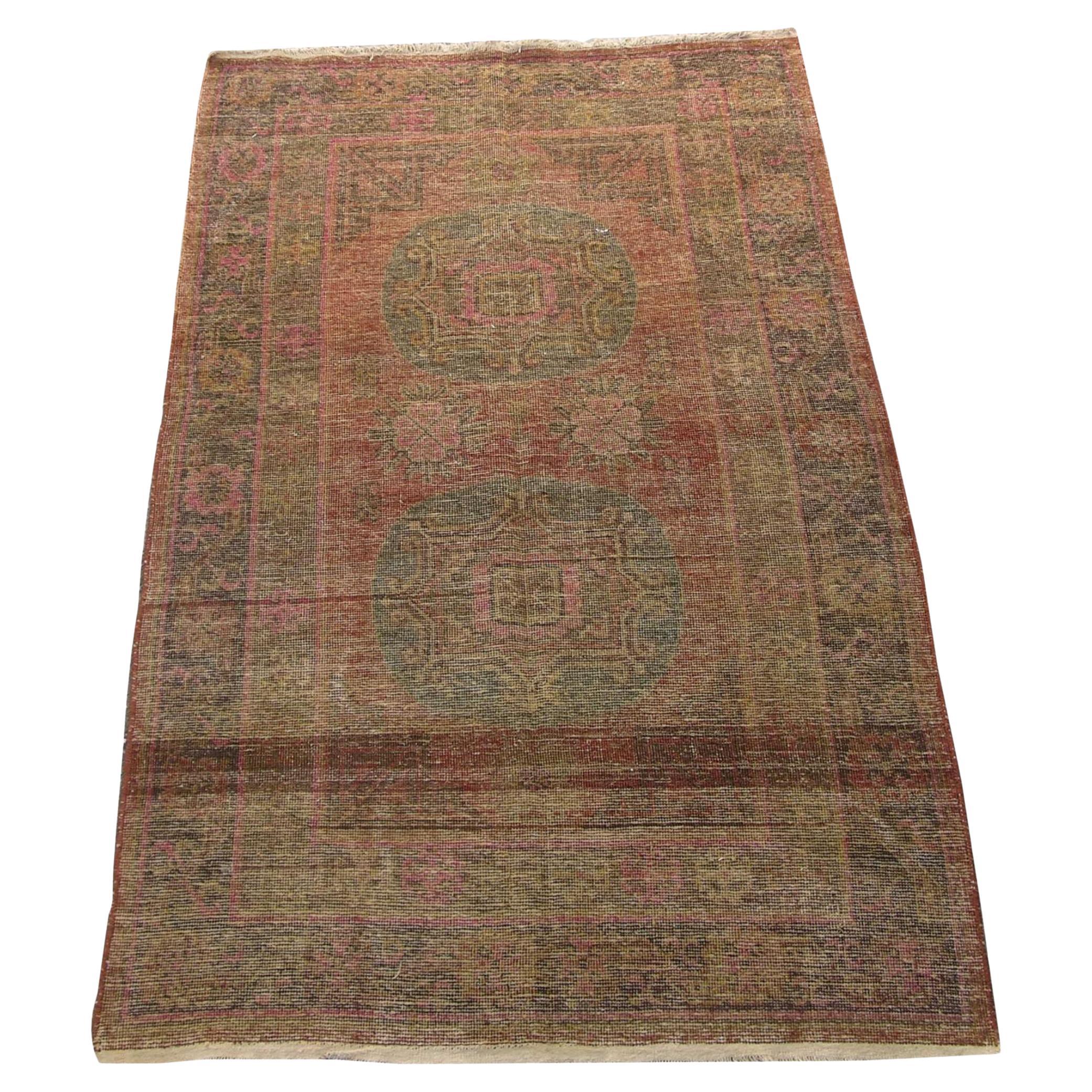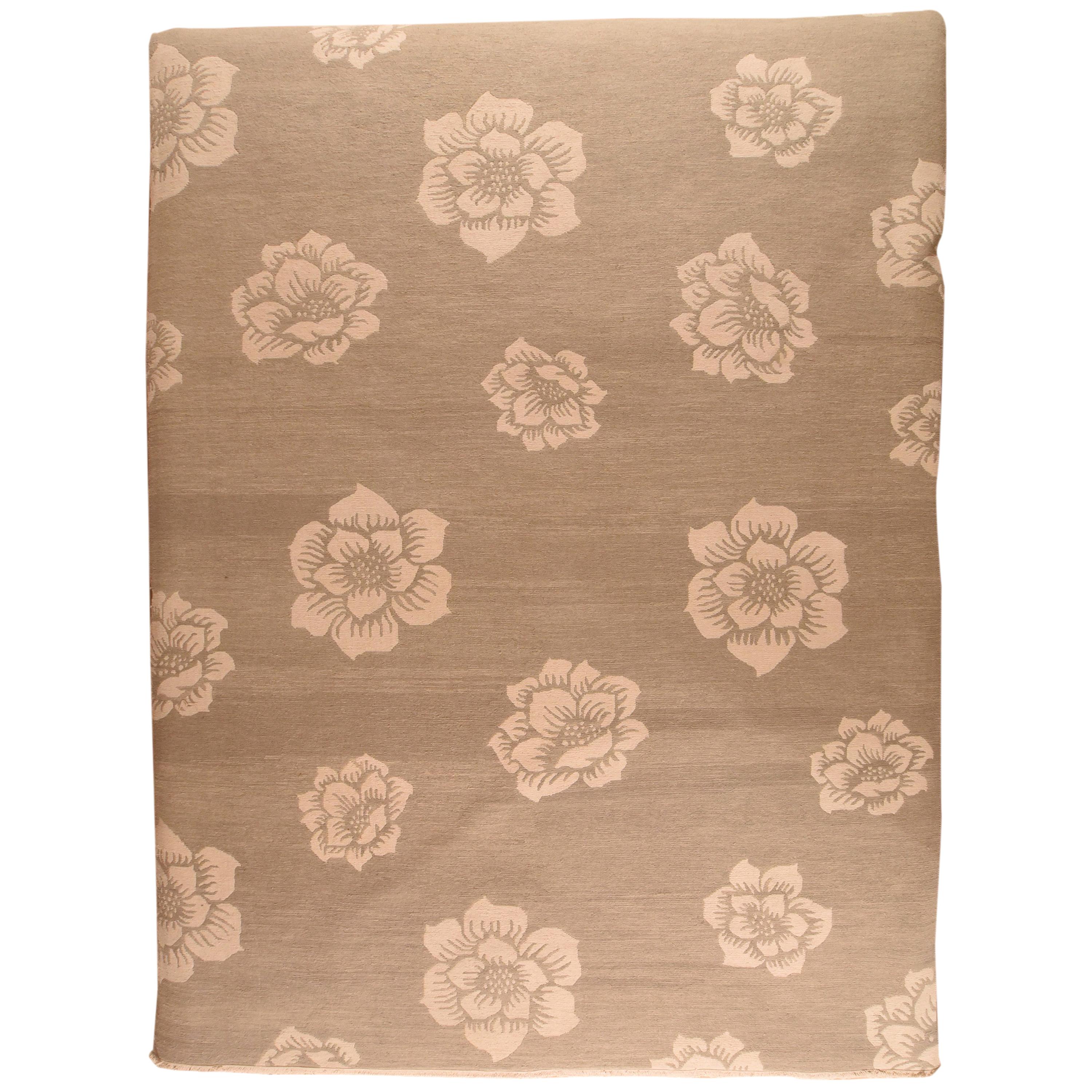Items Similar to Antique Nomadic Sumak Rug - 5'10'' X 4'3''
Want more images or videos?
Request additional images or videos from the seller
1 of 5
Antique Nomadic Sumak Rug - 5'10'' X 4'3''
About the Item
Antique Nomadic Rugs:
– To most people the concept of the area rug, especially the pile rug, is virtually synonymous with the Orient, above all Persia and Turkey. Flat woven floor coverings in plain weave or tapestry technique are to all intents ubiquitous. They were developed all over the world, in various materials, from the earliest times by all peoples who possessed the skill of weaving.
In the case of knotted or pile carpets and rugs, the source is not so generalized. There is no doubt that the Middle East from Persia to Turkey became the main region for knotted carpet production from the Middle Ages onward, but it is very unlikely they were invented and first produced there.
Pile carpets are most immediately a decorative textile substitute for furry hides or sheepskins. Like the latter, their function relates to insulation and comfort as well as décor. Such woven versions of hides or hide rugs evolved for various reasons.
First, by shearing the animals and weaving the rugs out of the wool, it was no longer necessary to kill the animals to have a rug. And by weaving the rug it became possible to make it into a piece of decoration as well. One could dye hides in one color, or in several swaths of color, but it was not easy to make anything approaching a design in this way, at least not with any intricacy or permanence.
But a woven pile rug, could be given some sort of design, just like flat-woven textiles, while also imitating the texture, density, and protective quality of fur hides. This is how the pile rug came to be born, but the question is where?
From the outset it seems improbable that such an adaptation of fur hides took place in the warm climate of the Middle Eastf, except for the mountainous regions of Turkey, the Caucasus, and Persia. But mainstream Oriental rug weaving has always been primarily an urban industry, not a production of remote highlands.
Moreover, the many archaeological discoveries made in the last century tend to indicate that the earliest carpets were produced and invented beyond Central Asia in the High Altai Mountains of Siberia to the north and west of Mongolia. The inhabitants there were tent-dwelling nomads whose material culture was dominated by textile production.
Such people required rugs to protect them from the elements, in addition to embellishing their domestic environment. It seems that these peoples created the knotted pile carpet by about 600 B.C., if not earlier.
The specific evidence for this comes from the discoveries made by Russian archaeologists at the frozen tombs of Bashadar and Pazyryk in the High Altai region. The site of Bashadar produced a fragment of a pile carpet carbon dated to the sixth century B.C. Unfortunately, no pattern is discernible on this fragment, but at Pazyryrk another pile carpet was discovered damaged but virtually intact, date-able to the fifth or fourth century B.C. After conservation, its color and design turned out to be nothing less than astounding.
The center of the rug had a king of chessboard design with small floral motifs in each square. The borders also had floral designs, as well as a frieze of horsemen, one of griffins, and another of fallow deer. The palette had rich reds, soft greens, blue, and gold, with a velvety pile.
Because of its design and technical sophistication, some scholars have doubted that the Pazyryk carpet was a product of antique nomadic rugs. The frieze of horseman and the floral designs are clearly related to ancient Persian art, especially the reliefs at the great site of Persepolis. The weaving technique is also very fine, which, to some scholars at least, suggests urban workmanship or origin. Consequently, the Pazyryk piece has often been touted as the world’s oldest Persian rug. But this is most unlikely.
Other frozen tombs at Pazyryk produced fragments of ancient Persian flat woven tapestry textiles with figurative decoration. Since such textiles were imported by the Altai nomads, it is easy to see how designs from Persian court art could have reached them. The desire to imitate such intricate tapestry designs also explains why the weavers utilized a finely knotted technique, in order to reproduce such delicacy and detail. In addition, the frieze of deer is not Persian. They come from the local repertory of Nomadic “Scythian” art.
The evidence of the wool and dyes in the carpet is also decisive. The wool is identical in type to the wool of sheepskin hides found in other tombs at Pazyryk, which were clearly local. The red dye in the carpet is made from lac or kermesic acid, derived from insects, and the particular type of lac is specifically Polish or Baltic in origin.
This dye would have been more readily available to the wide-ranging Eurasian nomads who lived from Eastern Europe to the High Altai than to the ancient Persians far to the south. It is therefore most likely that the Pazyryk carpet was woven locally by nomadic peoples, even though its design reflected the cosmopolitan influences of far-off regions. Scholarship has come to recognize, moreover, that nomadic Asiatic weavings – rugs, tapestries, and embroideries – produced at various times and places generally tend to reflect the impact of urban textile production from the Middle East. The Pazyryk carpet is simply an early example of this phenomenon.
But even if knotted pile carpets were developed by Central Asian or Altaic nomads, the idea, if not the actual carpets themselves would have reached the Middle East by ancient times where the technique would have been adopted in local production.
It is very likely that the ancient Persians also made knotted carpets like their nomadic neighbors to the north, but these have not been preserved. Nor do we have actual pile carpets preserved from Greek and Roman culture.
Classical textual references to carpets exist, but they are ambiguous; they could simply refer to flat-woven floor coverings or blankets. Not until late antiquity in the burials of fifth-century A.D. Roman Egypt do we again encounter actual pile carpets, made now in a looped technique.
Around the same time there is also continued evidence of carpet production from Central Asia and the Caucasus, where pile carpet fragments have been discovered in caves. Fragments of first century A.D. pile rugs discovered on the western periphery of China and Tibet suggest that the nomadic tradition of the knotted carpet spread east and southward from the Altai region as well.
- Dimensions:Width: 51 in (129.54 cm)Length: 70 in (177.8 cm)
- Style:Tribal (In the Style Of)
- Materials and Techniques:
- Period:1910-1919
- Date of Manufacture:1910
- Condition:Good Condition.
- Seller Location:Los Angeles, US
- Reference Number:
About the Seller
5.0
Gold Seller
These expertly vetted sellers are highly rated and consistently exceed customer expectations.
Established in 1920
1stDibs seller since 2023
26 sales on 1stDibs
Typical response time: <1 hour
- ShippingRetrieving quote...Ships From: Los Angeles, US
- Return PolicyA return for this item may be initiated within 3 days of delivery.
More From This SellerView All
- Antique Samarkand Rug 1900 -11'5'' X 5'10''Located in Los Angeles, USAntique Uzbek Samarkand Rug 11'5'' X 5'10'', tribal and traditional, antique and vintage, wool on cotton foundationCategory
Antique Early 1900s Uzbek Tribal Russian and Scandinavian Rugs
MaterialsWool, Cotton
- Antique Sumak RugLocated in Los Angeles, USSoumak rugs (also spelled Sumak) – This construction technique produces a flat-weave rug that is thick, strong and exceptionally durable. Unlike kilims, Soumak rugs are not reversibl...Category
Antique Early 1900s Other Russian and Scandinavian Rugs
MaterialsWool, Cotton
- Antique Uzbek Samarkand Tribal Rug 7'7'' X 4'3''Located in Los Angeles, USAntique Uzbek Samarkand Tribal Rug 7'7'' X 4'3''Category
Antique Early 1900s Uzbek Tribal Russian and Scandinavian Rugs
MaterialsWool, Cotton
- Early-19th Century Antique Chinese Small Rug - 5'10'' X 3'3''Located in Los Angeles, USAntique Chinese Rugs, as opposed to most of the antique rug productions, were woven almost exclusively for internal consumption. Since they were mostly sheltered from European and We...Category
Antique Early 1900s Asian Ming Russian and Scandinavian Rugs
MaterialsWool
- 1920 Antique English Fragment Rug 3'6'' X 4'3''Located in Los Angeles, USCa.1920 Antique English Fragment Rug 4'3'' X 3'6'', handmade and hand-knotted piece , came from Europe to america back in 1950s and was made by weavers in Europe around 1920s. Englis...Category
Vintage 1920s Asian Other Russian and Scandinavian Rugs
MaterialsWool, Cotton
- Antique Samarkand Rug 1900 -10'10'' X 5'6''Located in Los Angeles, USAntique Uzbek Samarkand Rug 10'10'' X 5'6''.tribal and traditional, antique and vintage, wool on cotton foundationCategory
Antique Early 1900s Uzbek Tribal Russian and Scandinavian Rugs
MaterialsWool, Cotton
You May Also Like
- Antique Kazak Rug 5'10'' x 13'8''Located in New York, NYAntique Kazak Rug 5'10'' x 13'8''. The tomato red field displays seven separate panels in dark red, green, navy, straw and beige. Birds in central green rectangle flanked by two pane...Category
Antique 1890s Russian and Scandinavian Rugs
MaterialsWool
- Sumak Manchoria Rug 10'0'' x 14'0''Located in New York, NYSumak (also spelled Soumakh, Sumak, Sumac, or Soumac) is a tapestry technique of weaving strong and decorative textiles used as rugs and domestic bags. Baks used for bedding are know...Category
21st Century and Contemporary Chinese Sumak Chinese and East Asian Rugs
MaterialsWool, Cotton
- Indian Sumak Manchoria Rug 10'0" x 14'0"Located in New York, NYSumak (also spelled Soumakh, Sumak, Sumac, or Soumac) is a tapestry technique of weaving strong and decorative textiles used as rugs and domestic bags. Baks used for bedding are know...Category
20th Century Chinese Sumak Chinese and East Asian Rugs
MaterialsWool, Cotton
- Indian Sumak Manchoria Rug 10' x 14'Located in New York, NYIndian Sumak Manchoria Rug 10' x 14'.Category
21st Century and Contemporary Chinese Sumak Chinese and East Asian Rugs
MaterialsWool, Cotton
- Vintage Sumak Manchoria Rug 10'0'' x 14'0''Located in New York, NYSumak (also spelled Soumakh, Sumak, Sumac, or Soumac) is a tapestry technique of weaving strong and decorative textiles used as rugs and domestic bags. Baks used for bedding are know...Category
20th Century Chinese Sumak Chinese and East Asian Rugs
MaterialsWool, Cotton
- Antique Caucasian Sumak Area RugLocated in New York, NYSoumak (also spelled Soumakh, Sumak, Sumac, or Soumac) is a tapestry technique of weaving strong and decorative textiles used as rugs and domestic bags. Baks used for bedding are kno...Category
Early 20th Century Russian Sumak Caucasian Rugs
MaterialsWool
